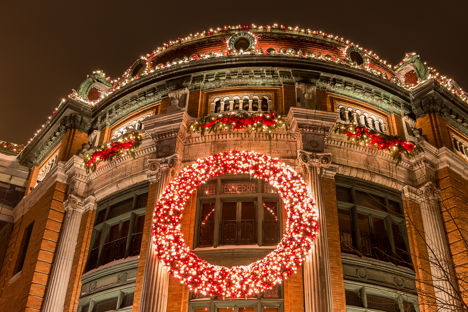
Christmas in Québec: the Réveillon
We’re no strangers to feasting through Christmas, but in French-speaking Canadian region of Québec Christmas Eve is a day when the meal to end all meals is served. Discover the banquet of the Réveillon and realise you’ve been celebrating the festive period all wrong.
Christmas in Québec: the Réveillon
We’re no strangers to feasting through Christmas, but in French-speaking Canadian region of Québec Christmas Eve is a day when the meal to end all meals is served. Discover the banquet of the Réveillon and realise you’ve been celebrating the festive period all wrong.
Figgy pudding, brandy butter, too many roast potatoes – Christmas dinner always leaves us reaching for the nearest digestif and snoozing in front of the TV afterwards. All over the world, overindulgence and celebratory dinners are par for the course during Christmas, and it’s when we spend more money on food and drink than any other time of the year. However, if you think the UK holds the number one spot for festive feasting, think again – the French-speaking areas of Canada have been banqueting on Christmas Eve for the past two hundred years, and the heady combination of both quantity and quality means it’s a dinner to remember.
This custom is known as the Réveillon, and has its origins in the nineteenth century – although back then the meal only consisted of a few biscuits and perhaps a piece of tourtière (a Canadian minced meat pie). But as food became less scarce and more families could afford it, the custom grew and grew into an incredible lavish feast. Today it is still enjoyed after midnight mass by a select few, but most tend to tuck in around dinnertime so they can enjoy Christmas Day as well.
It used to start after midnight mass and last until Christmas morning, until the children would come down to open their presents (the parents presumably would spend most of Christmas Day asleep!). The tradition fell out of favour towards the beginning of the twentieth century and became a custom only found in devout Catholic homes, but resurfaced in the 1990s when restaurants started serving Réveillon dinners at a more sociable time. Today, it’s celebrated at home once more, with the same core rule at its heart: the table must be adorned with the most luxurious food and drink the family can afford.
Traditionally, families would begin preparing dishes for Réveillon from the middle of November, ensuring there was plenty to tuck into come Christmas Eve. This was because at the first sign of cold weather in Canada, animals would be butchered into all sorts of cuts and either frozen in the snow or preserved. It made sense to prepare what was needed for the biggest meal of the year in advance, which is why so many Réveillon delicacies include black pudding, pâtés and meat pies.
The modern incarnation of the Révellion is still true to its roots, but there are all sorts of new dishes on the average dining table. Tourtières and meat-heavy dishes are still common, but now shellfish like Nova Scotian lobster and scallops sit alongside them. For dessert, the simple yet delicious Tarte au sucre is a must, comprised of a simple pie crust filled with brown sugar, cream and perhaps some chopped nuts, but it’s the Bûche de Nöel that really finishes off the night. Shaped like a yule log and not too dissimilar from a Swiss roll, this cake is decorated like a log and adorned with all sorts of wonderful festive decorations.
Despite all this incredible food on offer, it’s not what’s on the dinner table that has kept the Christmas tradition of the Réveillon alive over the centuries. It’s a time for family to get together in a world where they see each other less and less, let the younger children open a few smaller presents to quell their excitement for the day ahead, and perhaps indulge in a little fireside singing as the wine flows freely. The fantastic array of dishes on offer is, unbelievably, just the icing on the cake.
While most Canadians will swear their mother's tourtière is the best in the world, some families are more than happy to let someone else do all the hard work and go to a traditional restaurant. Here are some of the best in Québec City.
Restaurant Aux Anciens Canadiens is often cited as serving the best tourtière and tarte au sucre in the province, and hosts a grand Réveillon celebration every year.
Le Château Frontenac is a grand hotel steeped in Canadian history, and its Réveillon celebrations will transport you back to the nineteenth century.
Hôtel Le Concorde is right in the middle of downtown Québec, and its revolving restaurant Le Ciel rewards diners with panoramic views of the city.


